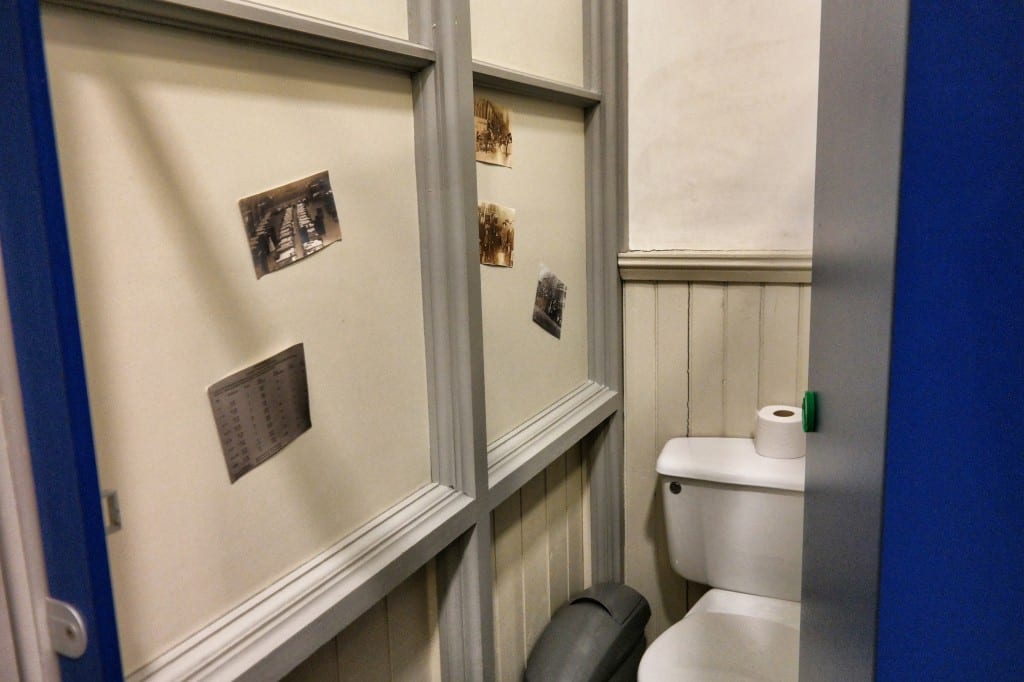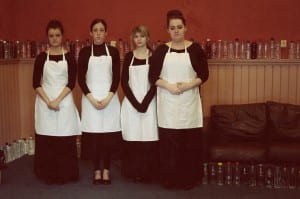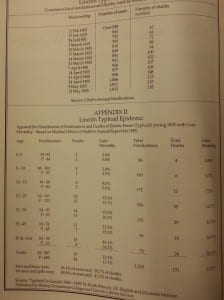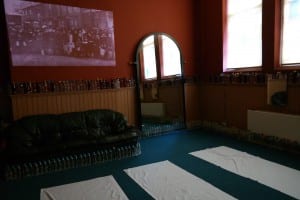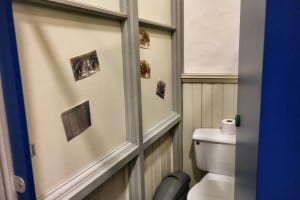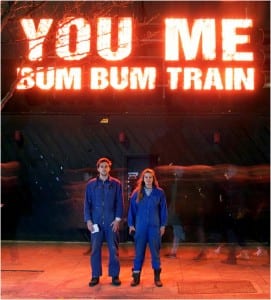“During the existence of the present outbreak of Typhoid Fever in the City the Inhabitants are particularly urged, as a matter of precaution, not to consume either WATER or MILK until the same has been THOROUGHLY BOILED
By Order of the Health Committee,
W. T. PAGE. JR.,
Deputy Town Clerk and Clerk to the Urban
Lincoln, Jan. 27th, 1905. Sanitary Authority.”
(Lincolnshire Archives, 2015)
FRAMING STATEMENT
Final Countdown is a fifteen minute site specific performance about the Typhoid epidemic which struck Lincoln in December of 1904 and lasted for about five months. The performance took place at the Lincoln Drill Hall which was used as a temporary hospital during the epidemic. Final Countdown is a sensory performance which, through the use of the five senses, takes three audience members at a time, on a journey to the past. The smell of the disinfectant, the sight of the water bottles and the photo of the people carrying buckets of water, the taste of the sweet water with the food colouring, and the hearing of the people’s stories about the Typhoid, are some of the things that are used to trigger the audience’s imagination and take them back in time. However, Final Countdown is not a performance that takes the audience a safe journey in which they can only relax and enjoy. The performance is about the death of hundreds and the agony of thousands of people from Lincoln who were affected by the disease. Once the audience members are offered and drink the ‘contaminated’ water they become the patients. From the second half of the performance, the ‘patients’ suffer from a variety of Typhoid symptoms, which are described by the actors, such as high temperature, cough, hallucinations and diarrhea. The actors, as the nurses, take care of the patients, and try to help them make it through all the four weeks that the disease lasts.
Final Countdown is dependent on the audience participation and their willingness to follow the actors’ directions. They have to drink the water with the food colouring and then close their eyes and keep them closed for the rest of the performance. When someone closes their eyes become vulnerable as they cannot see or control what is happening. Inevitably, Final Countdown is a piece that requires audience’s co-operation and, most importantly, immediate trust. The performance was influenced from different kind of theatre companies and artists such as the Curious and their performance On the scent, as well as You Me Bum Bum Train which is the work of two artists, Kate Bond and Morgan Lloyd. On the scent is an interactive performance which “explores the elusive connections between smell and memory” (Curious, 2008) while You Me Bum Bum Train transforms its audience into passengers who “[travel] in myriad ways through a warren-like space to encounter a series of intricately-created and often bizarre situations” (Hargreaves, 2014). Both performances, like Final Countdown, are intimate and rely on audience participation and trust.
“Whilst the auditorium often locates performance ‘over there’, necessitating projection and a particular economy of vocal and physical rhetoric, site-specific performance may be ‘just here’, ‘up close’” (Pearson, 2010, 176).
Final Countdown performed in two different rooms: The Green Room and the bathroom, which can be found at the back of the Drill Hall. Both of those spaces were small, providing a nice atmosphere and an intimate performance. For this reason, Final Countdown requires audience’s immediate trust as a lack of it would prevent them from fully experiencing the process.
ANALYSIS OF PROCESS
First thoughts…
“A visitor’s experience of the same place may invoke reactions and associations entirely differently from that of the inhabitants: it is possible to be in a place without realising its significance for the groups of people who have historically inhabited it”
(Pearson, 2010, 24).
Once I learnt about the history of the Drill Hall I knew that I wanted to work around the Typhoid Epidemic. The reason why was that I felt that people tended to remember the building more as a police and military training hall, rather than a hospital. Three of my classmates also expressed their interest on the Typhoid outbreak and we quickly teamed up, creating a group of four. When we started making our own research, we discovered a picture of the Drill Hall’s auditorium as it used to look like when it turned into hospital.
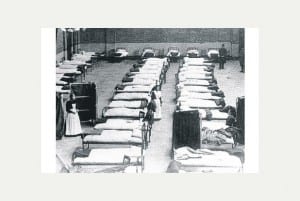
Source: http://www.lincolnshireecho.co.uk/100-year-old-promise-kept-following-typhoid/story-13417550-detail/story.html
The picture gave us great inspiration and we, instantly, started writing down our very first ideas. Our main goal was to make our audience realise that Typhoid was an important part of the history of the Drill Hall but also of the city. In addition to this, our first ideas included our desire to do a performance and an installation, which the latter would represent the number of people who hospitalised at the Drill Hall. More specifically, we wanted to create an installation with some kind of identification tags, in which the names of the patients could be found. However, it was impossible to find any and so therefore we kept researching. We were also playing with the idea to mark the spaces, where the beds used to be in the auditorium, in order to show how many people hospitalised at the Drill Hall and how crowded it must have been.
Archives…
Our visit to the Lincolnshire Archives played an important role and defined the nature of our performance. From the books that we found in the archives, we discovered that the cause of the Typhoid epidemic was the water which “was polluted with sewage” (Lincolnshire Archives, 2015). Since the water was the one that started everything, we wanted it to be the main element in our performance. For this reason, we decided to perform in the bathroom instead of the auditorium as it gave us the opportunity to experiment with the water but also provided us with a more intimate space. We also found pictures and stories from people who either lived during the epidemic or knew someone who lived at that time. From the stories we learned that the people were not allowed to drink water so they had to queue, holding buckets in their hands, in order to get fresh water from a cart that used to come once in a while in Lincoln. Indeed, some of the pictures were showing what it was described and they inspired us to do an installation with water bottles, to represent the people who were affected by the disease.
The total number of the people who suffered from the Typhoid was 1045 and we immediately started to collect bottles to reach our goal. We asked our classmates to keep their bottles for us and we took the University’s library permission to pick up their recycling bottles as well. In addition to this, we found that 131 people died during the epidemic and in order to represent them we decided to put red food colouring in the same number of the bottles we were about to collect.
The five senses…
In order to give the audience a better insight into people’s lives during the Typhoid epidemic, we decided to use all of the five senses:
I. Taste
The red food colouring served two different purposes in Final Countdown. As I mentioned before, we put it in some of the plastic water bottles to represent the number of people who died. In addition to this, we put it into plastic cups with water for the audience to drink and become the patients. In this case, the water with the red food colouring represented the contaminated water which people used to drink before they started getting sick. The food colouring made the water red and its taste to become slightly sweet. We hoped that this would help the audience realise that there must be something wrong with it. What is more, we decided, while giving the water to the audience, to act as if there is nothing in it. This was to highlight people’s ignorance about what was causing the disease.
II. Sight
In order to make the performance visually interesting we used the projection of the photo in which people could be seen waiting for clean water. The projection was on the wall above the bottles and we made it look like an old trembling film. The photo was also used to give the audience a better idea of how people looked like back in 1904 and stimulate their imagination. Additionally, we preset the 1045 water bottles around the room and we spread around them the 131 with the red food colouring. We hoped once the audience enter the room would be surprised of how many bottles there were and realise how many people were affected and killed by the disease.
III. Hearing
Once the audience entered The Green Room we gave them a few seconds to look around and then we asked them to lay down on the white sheets and close their eyes and keep them closed for the rest of the performance. By doing so we wanted to make the audience relax and concentrate to our voice while we were telling them the people’s personal stories that we found in the archives. The use of the personal stories was to create a connection between the audience and the people who experienced the Typhoid. The stories, in combination with the relaxing music from the projection, meant to calm the audience and make them feel safe. On the other hand, we wanted to achieve the exact opposite effect when the audience were placed inside the cubicles in the bathroom. For this reason, we were describing the symptoms of the four weeks of the disease with a tone of fear and panic in our voice. We were also playing with the different sounds of water to keep reminding to them the connection of the Typhoid with the water. For example, we kept filling the sinks with water and keep dipping our flannels into it to create dripping water sounds.
IV. Touch
By turning our audience into the patients, we wanted give them an idea of how it was to suffer from the disease. While they were sitting in the bathroom, having their eyes closed, we were touching them, as if we were examining them. In contrast with the Green Room, we wanted to make them feel uncomfortable and a bit scared of what it was going to happen next. Since their eyes were still closed, they would also feel vulnerable, like the way the victims of the Typhoid would have probably have felt.
V. Smell
The Typhoid victims suffered from a number of symptoms during a period of four weeks. The most dominant were high fever, pink spots and diarrhea. Having to take care of 100 sick people, as it was found in the archives, it would have meant that it could be impossible for the nurses to control the smell of the room. Consequently, we wanted to use different scents to represent the smell of the hospital. One way to do it was by giving people some disinfectant to clean their hands while entering the Green Room. Moreover, one of the reasons we chose the bathroom was of its natural smell of dumb in combination with the smell of the cleaning products that reminded that of a hospital.
Influences…
In the Site Specific Module, we were introduced to a number of practitioners and their work which influenced our piece.
I specifically liked Curious’s On the Scent, which inspired us to use the senses in our performance and be stimuli to the audience’s imagination. On the Scent is a performance that uses only the smell and “takes place in a domestic setting through which four audience members at a time are invited on intimate and aromatic journeys” (Curious, 2008). Apart from the different scents, there is a moment in the performance in which the actor eats a chocolate and describes the taste of it to the audience. I found this technique particularly effective as by using words such as “flowers” and “forced into cream” (curiousltd’s channel, 2008) it is like you can almost taste the chocolate yourself.
(curiousltd’s channel, 2008)
By describing the symptoms of Typhoid in detail to the audience we wanted to achieve just that, to make the audience feel as if it was really happening to them. We used phrases such as “You are constantly sweating and freezing at the same time”, “it’s hard to breathe” and “your abdomen is swollen and painful” (Papadopoulou et al, 2015) which hoped to put the audience into the shoes of the patients.
A performance that also influenced us was Kate Bond and Morgan Lloyd’s You Me Bum Bum Train. Even though you cannot find a lot about it in the official website, as the artists try to keep it secret from the audience in order to surprise them, there is some information in different online articles. In his online article, in theguardian website, Andrew Dickson refers to the performance “as a role-playing game” (2012) in which the audience become the passengers. The passengers walk through different spaces and, in each one of them, they have to take on a role, join the actors and become part of the performance. For instance, Dickinson, who describes his own experience of the performance, talks about him being asked to do different kind of tasks such as “to prep veg” or “to rinse someone’s bangs in a hair salon” (2012). We were very intrigued about the idea of people experiencing different kind of things, in different rooms, and we incorporated this in our final performance. More specifically, we wanted the audience to see the bottles and listen to the personal stories of the people in The Green Room and then, once they drink the water and become the patients, to be led in to the bathroom and experience the symptoms of the disease.
Another way to make the audience feel a sense of unease was by depriving them from their freedom to choose and by forcing them in a way to fully participate in the performance. This means that the audience were not given the choice to drink the water with the red food colouring in The Green Room as well as they were not given the choice to follow us to the bathroom and let us touch them as if we were examining them. Of course, they had the freedom to choose whether they wanted to participate in the performance in the first place but once entering The Green Room, they had to follow our instructions. This is the reason why it was important for the audience to trust us immediately as those who did not they would probably felt that the whole process was unpleasant.
A performance in which the audience was forced to participate in it, is Marina Abramovic and Ulay’s Imponderabilia (1977). In Imponderabilia the public had to walk through the two naked artists’ body in order to ender a museum. The fact the there was no other way to enter the building meant that the audience had no other choice but to squeeze between the two artists. Their only freedom that they had was, again, the choice to enter the museum or not.
(unraropersonaje, 2010)
PERFORMANCE EVALUATION
In general I was very pleased of how well the performance went. I was quite happy with the participation of the audience in our performance. Even though, we did not always have the three audience members which were required for our performance, I felt that it did not affect the overall experience. I also felt that we managed to make the audience realise how much the Typhoid affected people’s lives. The disease not only made the people of Lincoln suffer and some of them to die but also made the fear, of catching the disease, control their everyday lives. An example of this is the fact that “friendships had to be re-formed since many people would not allow their children to play with others” (Lincolnshire Archives, 2015). The only positive aspect of the Typhoid epidemic was the fact that the disease signalled the need for water of higher quality and it was the reason behind the construction of the pumping station in the city.
If I were to change something in Final Countdown it would be how far we went with the use of the five senses in our performance. To be more specific, I would like to experiment more with the taste and the smell. I felt that the use of the disinfectant as well as the natural smell of the bathroom was not as close as to the smell that would have been in the auditorium with the sick people. Symptoms like diarrhea as well as people’s sweat would cause a more unpleasant smell rather than the smell of the cleaning products. Consequently, I would like to experiment more with different scents and make the bathroom smell very unpleasant, causing different reactions from the audience.
The taste was also something that could have been improved in the performance as the only thing that the audience tasted was the water with the red food colouring. In the archives we found a number of different kinds of homemade remedies to help with the symptoms. I found particularly interesting the remedies they used for the headaches in which the patients were asked to “apply vinegar to [the] forehead and cover with brown paper” as well as the one for diarrhea in which they had to “pour boiling water over the berries and infuse for ten minutes” then “strain and serve with sugar” (Lincolnshire Archives, 2015).
I would have also avoided using the music in the Green Room as Conan, after participating in the performance, kindly advised us to turn it off. Unfortunately, the music worked against our idea to make the audience relax and concentrate in the stories we were saying. In contrast, it made it hard for the audience to hear our stories and instead of covering the traffic noises from outside it made it sound worse.
All in all, I feel very proud of our final performance and I believe we managed to pass the message that the Typhoid epidemic is an important part of the history of the Lincoln Drill Hall. The Site Specific Performance module also gave me all the necessary tools I will need after graduation and, consequently, I feel more confident to cope with the demands of a professional performance.
Word Count: 3060
Bibliography
Curious (2008) Curious home page. [online] Available from: http://www.placelessness.com/ [Accessed 12 May 2015].
Curiousltd’s channel (2008) On the Scent. [online video] Available from https://www.youtube.com/watch?v=BjiwsA96vZ8 [Accessed 13 May 2015].
Dickson, A. (2012) Best theatre of 2012, No 9: You Me Bum Bum Train. [online] London: Guardian News and Media Linited. Available from: http://www.theguardian.com/stage/2012/dec/11/best-theatre-2012-you-me-bum [Accessed 13 May 2015].
Hargreaves, R. (2014) Londonist. [online] London: LDN Creative Ltd. Available from: http://londonist.com/2014/11/you-me-bum-bum-train-announces-new-show.php [Accessed 12 May 2015].
Papadopoulou, E., Pyatt, A., Welberry, L. and Yngvell, M. (2015) Final Countdown. [performance] Lincoln: Lincoln Drill Hall, 8th May.
Pearson, M. (2010) Site-Specific Performance. Basingstoke: Palgrave Macmillan.
Unraropersonaje (2010) Ulay & Abramovic “Imponderabilia” [1977]. [online video] Available from https://www.youtube.com/watch?v=QgeF7tOks4s [Accessed 13 May 2015].
Visit to Lincolnshire Archives 13 February 2015
